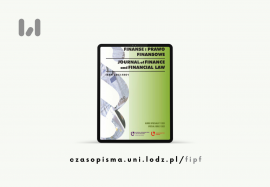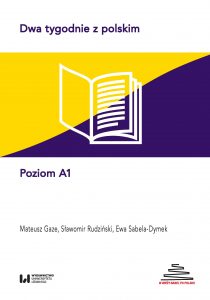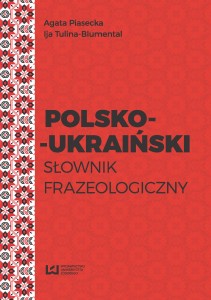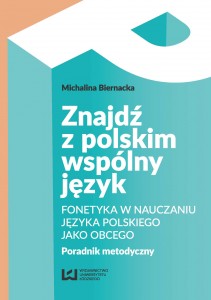Finanse i Prawo Finansowe | Nr 1 (2023): Numer specjalny / Journal of Finance and Financial Law | No. 1(2023): Special Issue
Opublikowano: 19 marca 2024

Kwartalnik JoFFL jest recenzowanym czasopismem naukowym, w którym zamieszczane są oryginalne artykuły naukowe, często łączące teorię z praktyką, odnoszące się do finansów oraz powiązanych z nimi dziedzin. Łamy czasopisma są otwarte również dla przedstawicieli nauk prawnych, którzy podejmują tematykę regulacji finansowych.
Celem czasopisma jest promowanie i publikowanie wyników badań z zakresu finansów, inspirowanie autorów, a także czytelników, do lepszego zrozumienia, zdefiniowania i wyjaśniania ważnych, w szczególności bieżących zjawisk oraz mechanizmów finansowych. Zadaniem czasopisma jest: udostępnienie forum do upowszechniania rezultatów badań oraz wymiany opinii, prezentacja indywidualnych i zespołowych dokonań naukowych.
Redakcja prowadzi stały nabór artykułów do czasopisma Finanse i Prawo Finansowe.
The JoFFL quarterly is a peer-reviewed scientific journal that publishes original research articles, often combining theory with practice, relating to finance and related fields. The journal is also open to representatives of legal sciences who take up the subject of financial regulations.
The aim of the journal is to promote and publish the results of research in the field of finance, inspiring authors, as well as readers, to better understand, define and explain important, in particular current financial phenomena and mechanisms. The task of the journal is to provide a forum for dissemination research results and exchange of opinions, presentation of individual and team scientific achievements.
The editors are constantly recruiting articles for the journal JoFFL.
W numerze 1(2023): Numer specjalny | Inside No. 1 (2023): Special Issue
Estimating the Share of Sickness Absence Costs in Europe’s GDP – a Country, Gender and Time Perspective
Katarzyna M. Miszczyńska, Elżbieta Antczak, Valentina Prevolnik Rupel
The purpose of the article. The aim of the study was to calculate and evaluate the costs of employee sickness absence in European countries over the period 2006–2020. An additional objective was to analyse the sensitivity of the development of absenteeism costs depending on the changing level of the discount rate used in economic evaluation analyses.
Methodology. The estimation and subsequent assessment of absenteeism of working-age people costs was based on human-capital approach and was carried out retrospectively using the morbidity, top-down approach, based on aggregated epidemiological data. As a measure of production loss volume, GDP per working person was adopted.
Results of the research. The study indicated that there is variation in the cost of sickness absence across European countries, but no clustering relationship was identified from a geographic perspective. In addition, SACS is in the range of 1,9% – 2,1% in all countries in 2006 prices.
Bibliometric Analysis of Studies on the Concept of Financial Literacy
Esra Sipahi Döngül, Tomasz Skica
The purpose of the article. This paper attempts to reveal the effect of the study by visually presenting the analysis of the studies on the concept of “financial literacy”.
Methodology. Bibliometric analysis of the studies published in the Web of Science (WOS) database between 1991 and 2023 was analyzed with the VOSviewer (Version 1.6.9) package program. Since the title, content, and keyword of the concept of “financial literacy” were intended to be scanned in all languages and all publication types, 2,889 works were accessed and analyzed. The limitations of the study are that only the studies in WOS are analyzed. No data from Scopus and PubMed databases has been included. For future studies, research from the Scopus and PubMed databases should be added.
Results of the research. When the most frequently included keywords in the publications related to the concept of “financial literacy” have a relationship between them at least twice in the study, the keywords “financial literacy” with 825 repetitions in terms of 1841 total connection strength, “financial education” with 111 repetitions in terms of 315 total connection strength, “financial behavior” with 65 repetitions in terms of 217 total connection strength and “financial knowledge” with 71 repetitions in terms of 213 total connection power are seen. As a result of the analysis performed, it was determined that there were 2265 connection powers and 4069 total connection powers for a total of 36 clusters. When we look at the year-by-year distribution, the most works were published in 2022 with a maximum of 426 works. At least one work was published in 2004, 2003, 1998, 1994 and 1991. Among the published studies, journal article 2,515, proceedings paper 280, early access 135, book chapters 101, review article 68, editorial material 29, correction 6, book 5, book review 3 were determined as works. When we look at the languages in which the published works are published, they are in English with a maximum of 2,814 works. At least two works are in French and Chinese. In order to determine the year-based stratification status of the published studies for country-based citations, it was noted that a country should have at least 1 study published and at least 1 citation obtained. As a result of the analysis, analysis was carried out on 78 observation units that were found to have a relationship between them, and it was determined that there were 14 clusters, 1065 connection power and 9417 total connection power. The countries with the most citations are the USA (11981 citations), the Netherlands (2445 citations) and England (1685 citations). In terms of the number of works, the ranking is the USA (197 publications), China (77 publications), India (73 publications), and Australia (70 publications). When the stratification status of the citation ties of the countries on a yearly basis is examined, it is seen that they are limited between 2017 and 2021.
Health Models – Financing and Effects: a Comparative Study of the Models in Poland and Italy
Bartłomiej Krzeczewski, Cesare Hassan
The purpose of the article. The study brings a comparative analysis between health systems in Poland and Italy. It is aimed at fulfilling the subject literature using economic comparative analyses between different health systems as well as straight comparisons between Polish and Italian health systems. Moreover, another aim of the study is to find out some weak points and to point out some good practices of each of the analyzed health systems. The research question for the purpose of this study is as follows: what changes can be implemented to improve the efficiency of each of the analyzed health systems?
Methodology. The study is carried out on the background of health systems’ theory. The critical literature review is conducted. A comparative analysis using such indicators as percentage of GDP and GDP per capita spent on financing health systems, healthcare spending components, life-expectancy data or Euro Health Consumer Index indicators are applied and analysed in the study.
Results of the research. Health systems in Poland and Italy in the latest decades were transformed in a completely different way. Healthcare in Poland is based mainly on health insurance premiums whereas in Italy financing of healthcare is based mainly on taxes. Among similarities between the systems a high level of responsibility designated to local authorities may be mentioned. The comparative analysis indicates that the situation of the Italian health system seems to be much better as compared to its Polish counterpart. Though, some solutions, aimed at improving health system efficiency, can be transferred from one system to another in case of both analyzed systems.
Next Pandemic? Yes, Please! How Covid-19 Pandemic Improved the Financial Condition of Polish Hospitals
Agnieszka Bem, Paweł Prędkiewicz, Rafał Siedlecki, Paulina Ucieklak-Jeż, Jan Žukovskis
The purpose of the article. The study aims to analyze how these special rules of financing during the pandemic affected the financial situation of hospitals in Poland.
Methodology. We analyzed a sample of 86 Polish hospitals from 2019 to 2021. The financial condition is assessed based on financial ratios and the synthetic measure M1. We employ the Kruskall-Wallis test to confirm the differences between the values of financial ratios in the analyzed period.
Results of the research. We confirm that due to the special rules and financing, combined with underperformance, the financial condition of Polish hospitals has slightly improved – especially in the case of operating margin, EAT to debt ratio and ROA.
Health Promotion in Schools – A Key to Improving Young People’s Health
Katarzyna Hampel, Paulina Ucieklak-Jeż, Agnieszka Bem, Zuzana Hajduova
The purpose of the article. The presented research aims to analyze the impact of health education on students’ attitudes towards taking care of their health, the health of other people and the ability to create a healthy environment. The paper assumes that health education is provided in schools by the applicable law. The work presents an up-to-date perspective on the complex problem of how young people perceive health.
Methodology. To verify the significance of the differences in the respondents’ assessments, statistical methods (non-parametric tests) were used: the U-Mann-Whitney test and the Spearman rank correlation coefficient. The calculations were made using Statistica. The research sample included young people from upper secondary and general education schools. The author’s questionnaire was used. The study was anonymous. Respondents completed the questionnaire voluntarily. The research was conducted between March and September 2023.
Results of the research. The conducted empirical analyses and the results of the surveys allowed us to achieve the goal assumed in the introduction and confirmed that health education in secondary schools influences the shaping of students’ attitudes towards taking care of their health and the health of the community in which they live. By implementing health education at school – according to the core curriculum – students’ awareness and motivation to undertake activities to improve and maintain good health is increased. Additionally, practical skills are developed to help them use the acquired knowledge in everyday life, and pro-health attitudes are formed. Health promotion is, therefore, the key to improving the health of school children, preparing them for a healthy lifestyle and making informed choices about their health and the community in which they live.
Preface
Katarzyna Miszczyńska
Komentarze
Ten post dostępny jest także w języku: angielski





